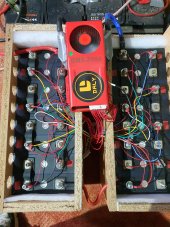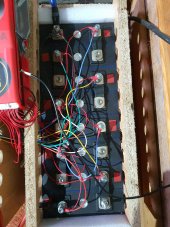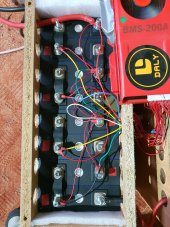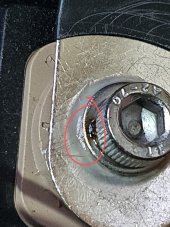Hello my friends,
quite new to DIY battery packs but I would say, that I am really sure what I am doing from an electrical perspective - until now .
.
I finished my first project with building a ~10KWh 16S 48V LiFePo4 battery for my 5KW hybid inverter which is connected to 10 of 310W mono-solarpanels. So far so good. System was running quite well with the LiFePo4 pack for several weeks until I noticed that the cells getting quite unbalanced when going from ~80% to 100% SOC - even I initially top-balanced them at the beginning. So I just ordered an 16S active balancer from AliExpress (Heltec: https://www.aliexpress.com/item/4000938109615.html?spm=a2g0s.9042311.0.0.701c4c4dGOoFQ9) with a maximum balance current of 5A - which seemed really nice and useful to me.
When it arrived a week ago I instantly installed this little PCB with its wires as explained in the manual (https://diysolarforum.com/resources/heltec-capacitive-active-equalization-active-balancer.204/). So connecting the first B- wire to the same battery pole as the BMS (Daly BMS 16S 200A) and then connecting each positive pole in the correct order. Before connecting the balancer I measured each connector/cable to ensure the correct connection order - everything fine, same procedure as connecting the BMS.
Now after 3 days of working really well and without any issues, I decided to make a stress test of the whole system with the battery at 100% SOC. I started with 1KW consumption (~20A) up to 4KW (~83A). When I plugged in the last device with 2.2 KW consumption the BMS did cut off the whole pack. While this happened I noticed the BMS showing one cell with >4V for around 2 seconds. So... I tried the same test again. But now (also the BMS did cut off the battery) the balancer short-circuted with a little spark and a few seconds later (when the battery pack was definitly cutted of) 3 capacitors of the PCB just "popped" / exploded off. That was really a shocking moment and I thought "alright, thats it, everything will be broken now". After I securely disconnected the balancer, I checked every cell and the BMS and everthing seems alright for now - exept the balancer, which is completely destroyed.
NOW the final questions: how the f*ck could this happen? Was it my fault or was the balancer faulty since the beginning? I was hitting 80A to 90A consumption, was it too much for the balancer? What is the maximum consumption you can draw with an active balancer?
Thank you all in advance for your expertise on this topic!
Best regards
Paul
quite new to DIY battery packs but I would say, that I am really sure what I am doing from an electrical perspective - until now
I finished my first project with building a ~10KWh 16S 48V LiFePo4 battery for my 5KW hybid inverter which is connected to 10 of 310W mono-solarpanels. So far so good. System was running quite well with the LiFePo4 pack for several weeks until I noticed that the cells getting quite unbalanced when going from ~80% to 100% SOC - even I initially top-balanced them at the beginning. So I just ordered an 16S active balancer from AliExpress (Heltec: https://www.aliexpress.com/item/4000938109615.html?spm=a2g0s.9042311.0.0.701c4c4dGOoFQ9) with a maximum balance current of 5A - which seemed really nice and useful to me.
When it arrived a week ago I instantly installed this little PCB with its wires as explained in the manual (https://diysolarforum.com/resources/heltec-capacitive-active-equalization-active-balancer.204/). So connecting the first B- wire to the same battery pole as the BMS (Daly BMS 16S 200A) and then connecting each positive pole in the correct order. Before connecting the balancer I measured each connector/cable to ensure the correct connection order - everything fine, same procedure as connecting the BMS.
Now after 3 days of working really well and without any issues, I decided to make a stress test of the whole system with the battery at 100% SOC. I started with 1KW consumption (~20A) up to 4KW (~83A). When I plugged in the last device with 2.2 KW consumption the BMS did cut off the whole pack. While this happened I noticed the BMS showing one cell with >4V for around 2 seconds. So... I tried the same test again. But now (also the BMS did cut off the battery) the balancer short-circuted with a little spark and a few seconds later (when the battery pack was definitly cutted of) 3 capacitors of the PCB just "popped" / exploded off. That was really a shocking moment and I thought "alright, thats it, everything will be broken now". After I securely disconnected the balancer, I checked every cell and the BMS and everthing seems alright for now - exept the balancer, which is completely destroyed.
NOW the final questions: how the f*ck could this happen? Was it my fault or was the balancer faulty since the beginning? I was hitting 80A to 90A consumption, was it too much for the balancer? What is the maximum consumption you can draw with an active balancer?
Thank you all in advance for your expertise on this topic!
Best regards
Paul
Last edited:







